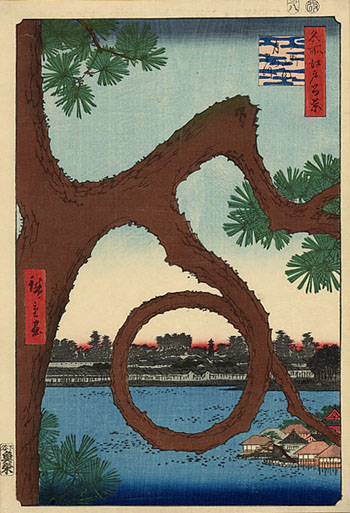| Search Art Prints | ||||||||||||||||||||
| Search Artists | ||||||||||||||||||||

|
||||||||||||||||||||
|
|
|||||||||||||||||||

Moon Pine, Ueno

|
Moon Pine, Ueno
As part of a series of 100 woodblocks (actually 118), ‘Moon Pine, Ueno’ was created by Ando Hiroshige in 1857. It is number 89 in the collection. The series, which is entitled “100 Famous Views of Edo” (Edo now being Tokyo), was completed in a mere 2 years, from 1856 to 1858, the year of Hiroshige’s death. The medium used was thick mulberry bark, a wood that accentuates the bright colors and natural textures.
The remarkable tree in the painting received its name due to one full-moon-shaped contorted branch, a common natural phenomenon found in many very old Japanese pines. It was believed that when a person examined the looped branch from different angles, the various moon phases could be observed as well. The coarse wood grain textures the pale blue sky and tranquil water, and purposely underplays the magnificent, prominent, twisted tree. Small fish can be seen through the surface of the water. There are three fire towers in the distance; the centered one encircled by the branch is believed to have been situated in the main estate of the Maeda, Lord of Kaega. This land now belongs to the University of Tokyo.
Hiroshige painted the Moon Pine again in number 11 of the series. He entitled it “The Kiyomizu Temple and Shinobazu Pond at Ueno”. It is a distant view of the tree, and therefore not the main focus of the painting.
The peaceful, serene atmosphere of ‘Moon Pine, Ueno’ transcends, and permeates the mind of viewers. Vincent van Gogh so admired Ando Hiroshige’s work that he purchased many of his prints.
Memorable Ending for the Artist
Ando Hiroshige retired from “the world” and became a Buddhist Monk in 1856, which is the year he began the series “100 Famous Views of Edo”. Just before his death in 1858, he wrote this beautiful poem:
“I leave my brush in the East
And set forth on my journey.
I shall see the famous places in the Western Land.”
The Western Land refers to a strip of land by the Tokaido, between Kyoto and Edo, but was also meant to signify the Paradise of the Amida Buddah in the afterlife.
Number 89, ‘Moon Pine, Ueno’, is currently located at the Brooklyn Museum in New York. Due to the prints’ fragile nature, they are only physically displayed for limited periods of time in order to protect them. However, the series can be viewed online in its entirety at the Brooklyn Museum’s website.











